Here's some frequency response plots. I did these with Arta and measured in my living room with a very short gate. Due to the short gate the low resolution accuracy will be iffy. (Should be good above 500hz.) Each plot is at zero degrees (yellow), 22.5 degrees (orange), and 45 degrees (red)
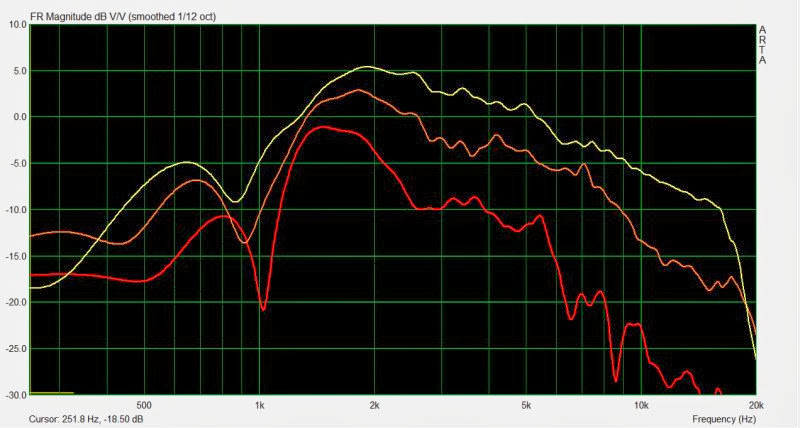
These are the horizontal polars. I'm running the horn flipped 90 degrees, so these polars will be different than what you see from other users. (Will be the same as their verticals.) In the graphs we see that the midrange is quite low, but this is due to the fact that I only have one midrange on the horn, not four. Once I add three more the level will rise by about six decibels. There's also an off-axis dip due to it being a dipole, and that peak is higher in frequency than the last horn because this horn is smaller.

Here's the vertical polars. Same setup as the last graph, which is one compression driver and one midrange mounted on the horn. The dipole dip is a little bit lower in frequency because the horn is taller than it is wide.

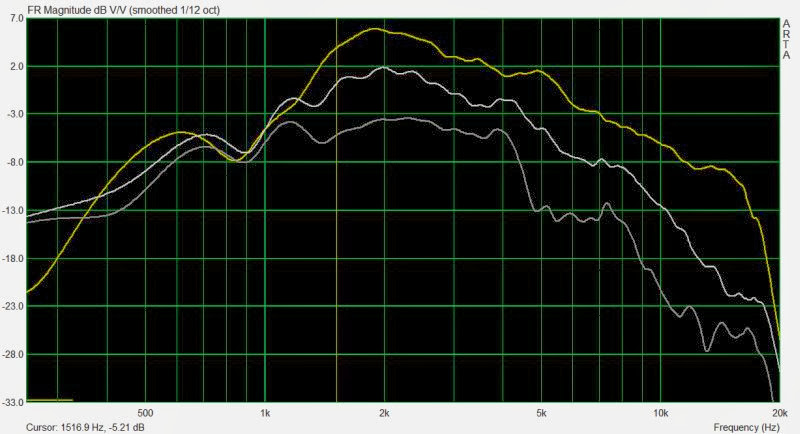
Here's where things get interesting. As I've noted on some other threads, I really like the sound of PK Sound cardioid subs, and the Gradient Helsinki cardioid. And I think that my Synergy horn will be cardioid-ish, not dipole or monopole. In the graph above, I have reduced the output of the midranges. I did this with a very sophisticated device.
I wrapped a wool scarf around the horn tightly 🙂
But this worked pretty good I think. Here's some advantages we see:
1) The cardioid-ish response is much smoother in the high frequencies. I believe this is because the scarf is reducing the output from the midranges, so that it doesn't interfere with the compression driver. The reason that we have to do this is because the front of the midranges is filtered by the coupling chamber and the horn, but the output radiating from the rear of the cones is unrestricted. And due to that, as you move off axis on the dipole, you get ripples in the response. Going cardioid cleans that up, as you can see in the off axis response particularly at 45 degrees.
2) Going cardioid-ish reduces the depth of the dipole dip around 900hz
3) On the downside, going cardioid-ish reduces the low frequency output level. (Because there are frequencies where the front and back combine constructively.) But this isn't a big deal, because we have tons of midrange output once we put four midranges on the horn.

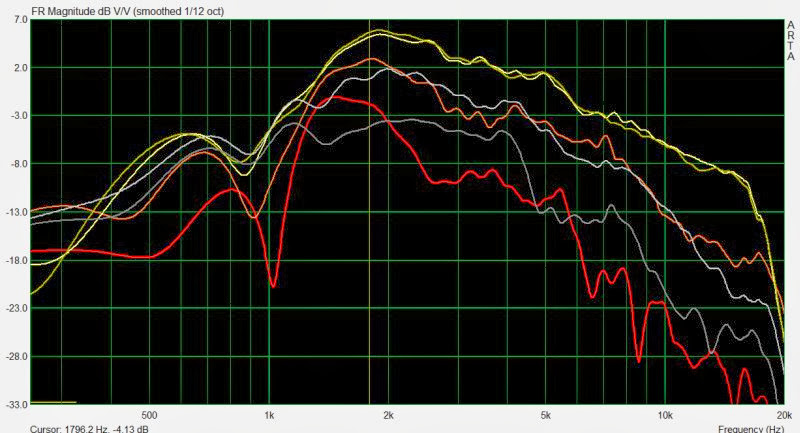
Here's the cardioid-ish response by itself, and on the same graph as the dipole for comparison's sake.

These are the horizontal polars. I'm running the horn flipped 90 degrees, so these polars will be different than what you see from other users. (Will be the same as their verticals.) In the graphs we see that the midrange is quite low, but this is due to the fact that I only have one midrange on the horn, not four. Once I add three more the level will rise by about six decibels. There's also an off-axis dip due to it being a dipole, and that peak is higher in frequency than the last horn because this horn is smaller.

Here's the vertical polars. Same setup as the last graph, which is one compression driver and one midrange mounted on the horn. The dipole dip is a little bit lower in frequency because the horn is taller than it is wide.


Here's where things get interesting. As I've noted on some other threads, I really like the sound of PK Sound cardioid subs, and the Gradient Helsinki cardioid. And I think that my Synergy horn will be cardioid-ish, not dipole or monopole. In the graph above, I have reduced the output of the midranges. I did this with a very sophisticated device.
I wrapped a wool scarf around the horn tightly 🙂
But this worked pretty good I think. Here's some advantages we see:
1) The cardioid-ish response is much smoother in the high frequencies. I believe this is because the scarf is reducing the output from the midranges, so that it doesn't interfere with the compression driver. The reason that we have to do this is because the front of the midranges is filtered by the coupling chamber and the horn, but the output radiating from the rear of the cones is unrestricted. And due to that, as you move off axis on the dipole, you get ripples in the response. Going cardioid cleans that up, as you can see in the off axis response particularly at 45 degrees.
2) Going cardioid-ish reduces the depth of the dipole dip around 900hz
3) On the downside, going cardioid-ish reduces the low frequency output level. (Because there are frequencies where the front and back combine constructively.) But this isn't a big deal, because we have tons of midrange output once we put four midranges on the horn.


Here's the cardioid-ish response by itself, and on the same graph as the dipole for comparison's sake.
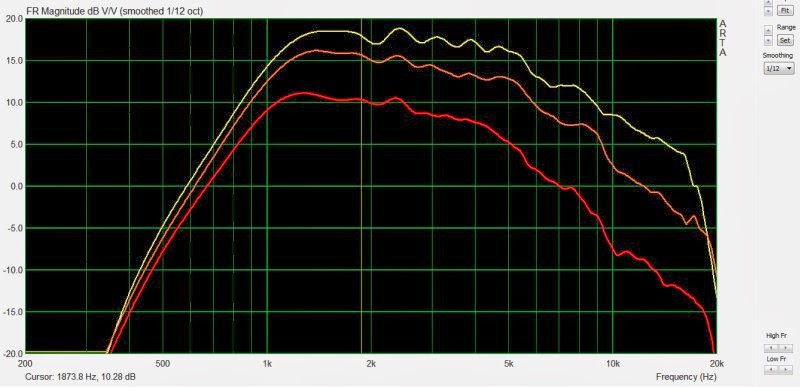

Here's the response with the tweeter on the QSC horn, from about a week and a half ago, versus the current response, with one midrange one tweeter and two midranges holes. (cardioid-ish, with a scarf wrapped around the horn.) As you can see, the midrange holes definitely have an effect on the response, even at high frequency.
A monopole horn (should) have a response which covers a desired area and reduces in level outside that area.I think that my Synergy horn will be cardioid-ish, not dipole or monopole.
A cardioid response has reduced level 180 degrees behind the "normal" direction it is pointed, same as a monopole horn.
A dipole should have a response equal in both directions over it's passband with the rear lobe reversed polarity from the front lobe.
Your horn with open backed (or wool covered) midrange will not have any of the above patterns.
Previously you have stated a preference for narrow vertical and wide horizontal coverage, why are you placing this horn contrary to the pattern you prefer, and it was designed for?
What SPL can the open back midrange achieve in the 200-500 Hz range before it starts to fart/flap?
A monopole horn (should) have a response which covers a desired area and reduces in level outside that area.
A cardioid response has reduced level 180 degrees behind the "normal" direction it is pointed, same as a monopole horn.
A dipole should have a response equal in both directions over it's passband with the rear lobe reversed polarity from the front lobe.
Your horn with open backed (or wool covered) midrange will not have any of the above patterns.
Yes, this is uncharted territory. But I've heard the Emerald Physics speakers that are dipole with waveguide, and the imaging is exceptional. I believe that this is due to the reduction in output to the sides due to the dipole radiation.

A speaker on a 25cm x 25cm baffle will have a peak at 1350hz due to the output from the rear combining with the output from the front in-phase. (Front is 180 degrees out of phase with the back, but there's 180 degrees of phase rotation due to traveling 12.5cm to reach the edge.) At one octave above that frequency we'll see a dip, but the severity of that dip will depend on the directivity.
In my dipole measurement above, we see the peak and the dip, but the dip is at 1khz not 2700hz. This is likely due to a number of factors:
1) The midranges are not centered
2) The baffle is not flat, it is a waveguide
3) There's a coupling chamber in front of the mids
It's hard to tell where the dipole peak is, because of my very short gate. I'd hoped that my measurement was good to 500hz, but it may be less, because I'm doing this in my living room. Theory says that the dip at 1khz should be accompanied by a peak at 500hz. The amplitude of the dipole peak will depend on the baffle size and shape, but the frequency should be a multiple of 1khz. The amplitude of the dipole peak may be masked by the rolloff that occurs due to the small baffle.
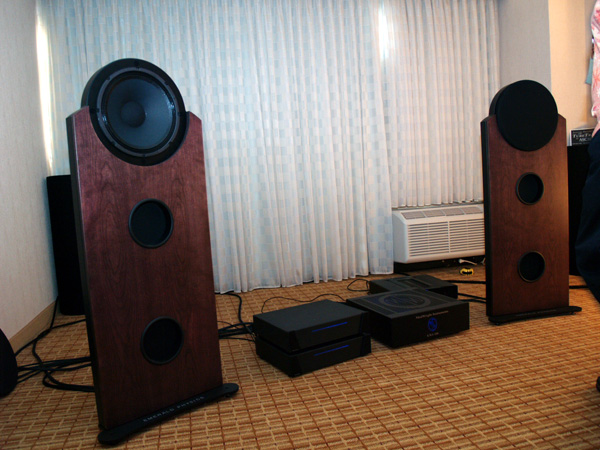
Again, this is similar to the Emerald Physics speakers. I've heard them, they sound excellent, I nearly bought them. In the Emerald Physics the woofer fires through a coupling chamber, the back is open to the room.
Previously you have stated a preference for narrow vertical and wide horizontal coverage, why are you placing this horn contrary to the pattern you prefer, and it was designed for?
Cosmetics. The girlfriend doesn't want a half meter wide speaker in the living room. Flipping the waveguide makes the cabinet skinnier, and since this is a Synergy Horn we don't have to sweat the center-to-center spacing like we would if I was using a crossover at 1khz.
What SPL can the open back midrange achieve in the 200-500 Hz range before it starts to fart/flap?
Output won't be a problem. These Dayton ND91s have WAY more output than the midranges used in the SH-50. Those Celestions have an xmax that's a fraction of what the ND91s do. And on the LeCleach horn the array of four had nearly as much output as the compression driver, which is quite amazing for such a low efficiency driver.
Right now my main concern about the ND91s is the size of the midrange taps; due to the amount of air they can move, a large tap is required. In the graph I posted from a couple hours ago you can see that two midrange taps are screwing up the response, so I shudder to think what eight will do. Hopefully I can reduce the effect by stuffing the midrange ports.
Patrick, thank you for sharing.
It's a great idea to use QSC horn for Synergy, but Dayton ND91s... I doubt it. They do have Xmax way more then those Celestions or Visatone, but regarding SQ it's totaly different liga. It's has character close to Aura, but you can't compare them with solid drivers.
And I don't like Aura with same aluminum cones in Synergy at all. It has some 'synthetic' and 'compressed' sound compared to paper drivers. NO air! Maybe they measure up good, but no natural sound. At least for my ears. I want to try your idea with better drivers.
It's a great idea to use QSC horn for Synergy, but Dayton ND91s... I doubt it. They do have Xmax way more then those Celestions or Visatone, but regarding SQ it's totaly different liga. It's has character close to Aura, but you can't compare them with solid drivers.
And I don't like Aura with same aluminum cones in Synergy at all. It has some 'synthetic' and 'compressed' sound compared to paper drivers. NO air! Maybe they measure up good, but no natural sound. At least for my ears. I want to try your idea with better drivers.
And I don't like Aura with same aluminum cones in Synergy at all. It has some 'synthetic' and 'compressed' sound compared to paper drivers. NO air! Maybe they measure up good, but no natural sound. At least for my ears. I want to try your idea with better drivers.
I haven't tried any of the 2" aluminium cones so can't comment on them directly but this statement puzzles me - many many Pluto owners are happy with them as tweeters. I can't see where a problem could be with using them in the octaves around 1 kHz - breakup modes would be way higher up. How steep were your crossovers when you tried them?
Personally I'm plodding towards a room corner (floor level) synergy horn with a planar driver at the vertex and either Vifa TC9 or Fountek FR88EX as mids, since I have them on hand. I'll have to compare these paper and alu cones when I get to that point.
Patrick, thank you for sharing.
It's a great idea to use QSC horn for Synergy, but Dayton ND91s... I doubt it. They do have Xmax way more then those Celestions or Visatone, but regarding SQ it's totaly different liga. It's has character close to Aura, but you can't compare them with solid drivers.
And I don't like Aura with same aluminum cones in Synergy at all. It has some 'synthetic' and 'compressed' sound compared to paper drivers. NO air! Maybe they measure up good, but no natural sound. At least for my ears. I want to try your idea with better drivers.
I've tried a pile of drivers; literally 10-20. Some observations:
1) The big closed back drivers, like the Pyle 5" and the Misco 5" used in the Sound Physic Lab speakers work fine, but you have to push the compression driver to get it to play low enough.
2) Paper cone drivers like the TangBand W2-854SH and the Parts Express $2 buyout drivers basically sound like the Misco and the Pyle, but it's easier to cross them over to a compression driver.
3) The aluminum cone drivers are a bit of a crapshoot. Theoretically, they shouldn't work, their EBP is wrong. But 'in the real world' their high frequency output is more extended than the predictions would show.
The primary difference is harmonic distortion. The aluminum coned Peerless and the Dayton ND91 have a copper cap on the pole to reduce harmonic distortion. For the Dayton, this is particularly important, since I'm running it open back, which increases excursion, which increases distortion. Note that the cheaper ND90 *doesn't* have this feature. The ND91 was a refinement of the ND90, which is a clone of the Aurasound NS3. Speaker icon and all around genius Don Keele asked for the changes.
The Fostex is a lovely driver; it's amazing how careful refinement of a low tech driver can attain such extended response. Little things like the aluminum dustcap which acts like a tweeter at high frequency. But all of that goes to waste in a Synergy horn, because the coupling chamber rolls off 75% of the drivers bandwidth.
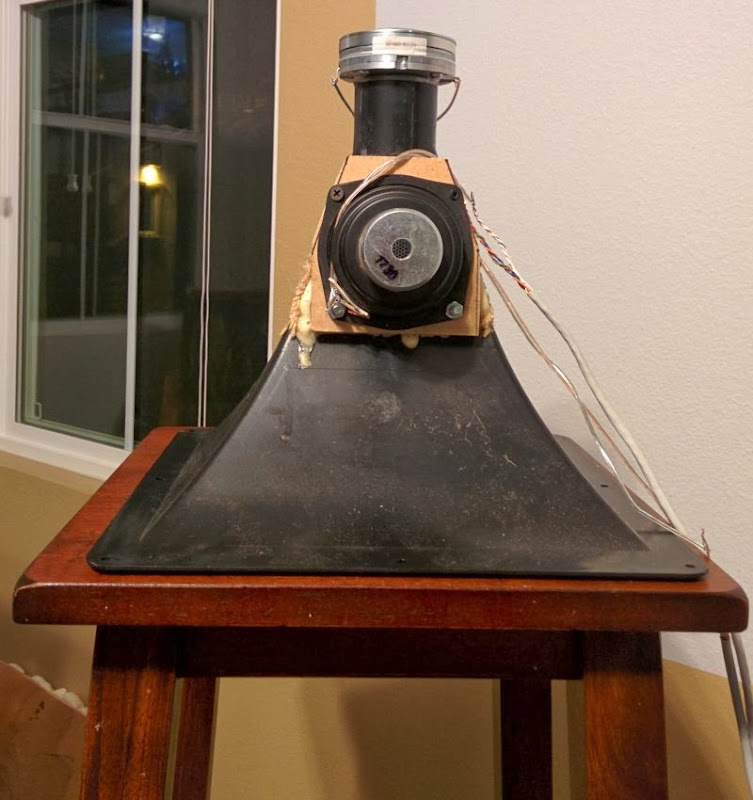
I decided to give the Pyle PH12S a try as a Synergy horn. It combines some of the good features of both the QSC and the LeCleach:
1) It's build quality isn't quite as good as the QSC, but it's much better than my fiberglass horns
2) It has narrower coverage than the QSC, which I personally prefer
3) It loads the midranges down to a lower frequency
On the downside, it has a diffraction slot. So I'll probably build both the QSC and the Pyle, and decide which one to keep based on which sounds better.
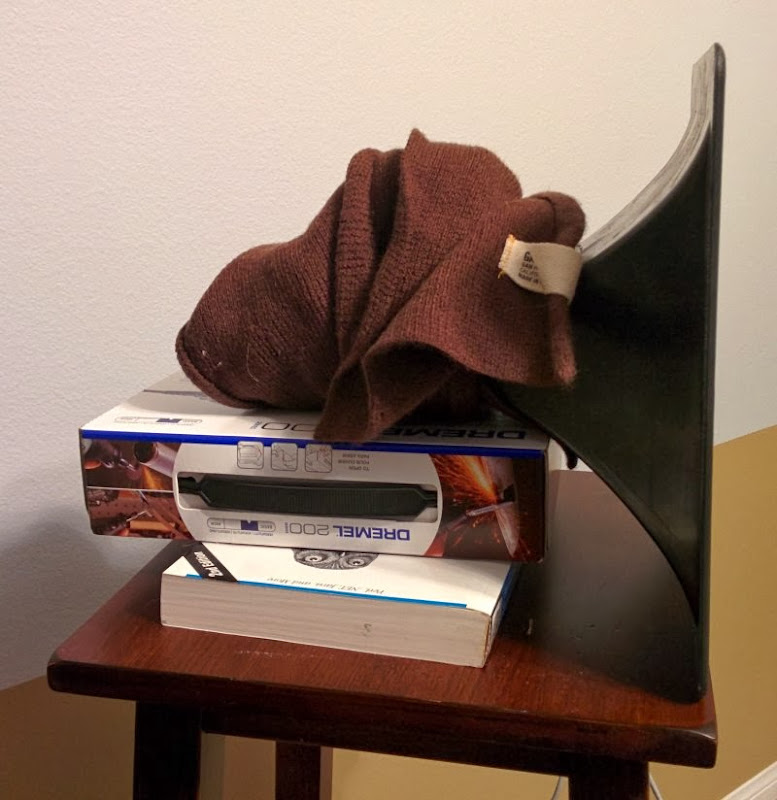
Hi-tech cardioid treatment
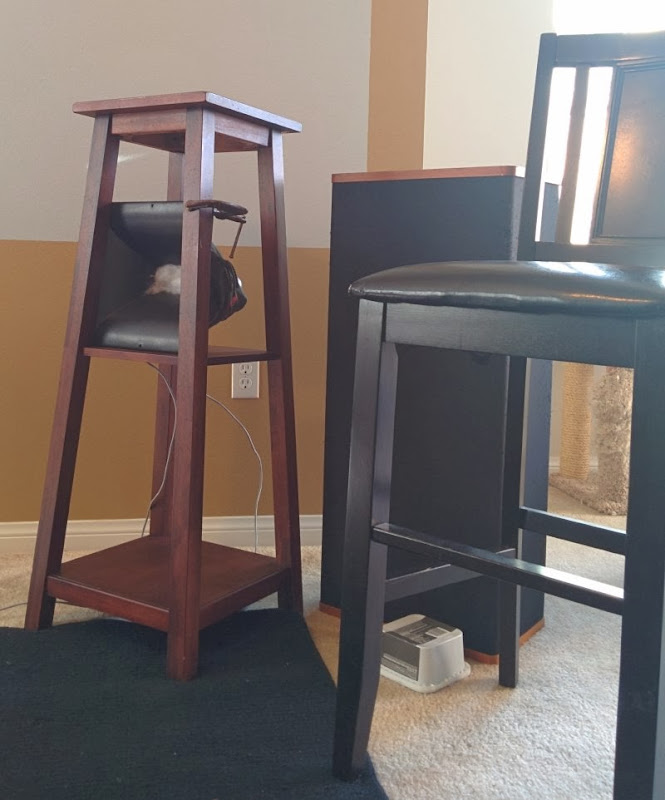
I had an idea for how to build the cabinet.
Initially I was going to make it out of wood, foam and fiberglass. But it hit me that I could make an enclosure similar to the Vandersteen by using a hardwood plant stand, or even a bar stool.
Here's all three, to give you and idea of the scale.
Here's some advantages:
1) No need to build a cabinet. Basically just bolt the horn to the plant stand, then wrap the whole thing in fabric like the Vandersteen.
2) No need to finish the wood.
3) My craftsmanship is awful, and using a pre-built stand would likely look better.
An externally hosted image should be here but it was not working when we last tested it.
Here's the bar stool I settled on. It's from Wal Mart, sells for $29. (Not my house, just a pic I found online.)
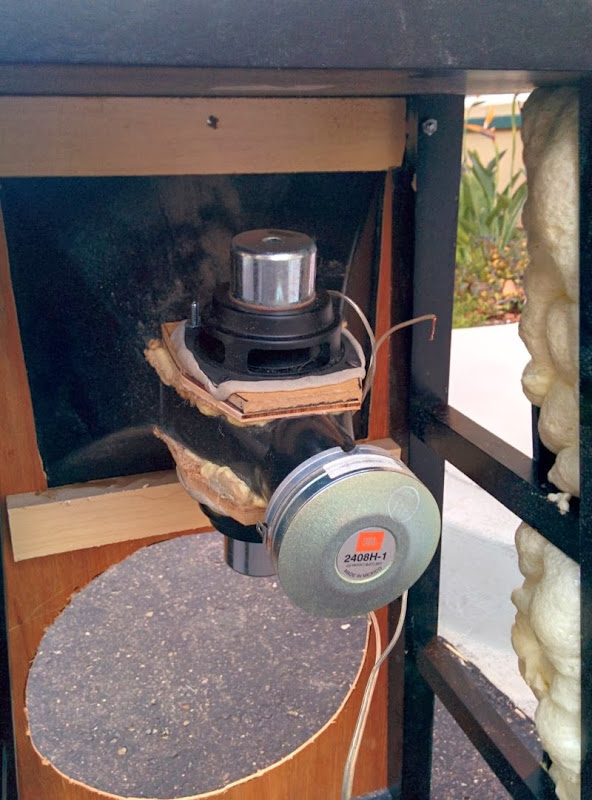


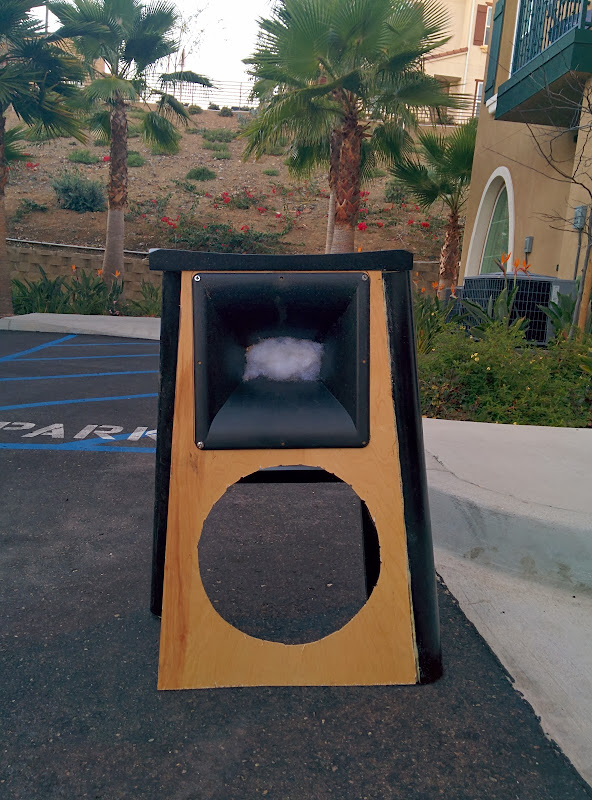
Some pics of the speaker coming together. Still need to mount the woofer.
Will it be that much smaller than the summa?
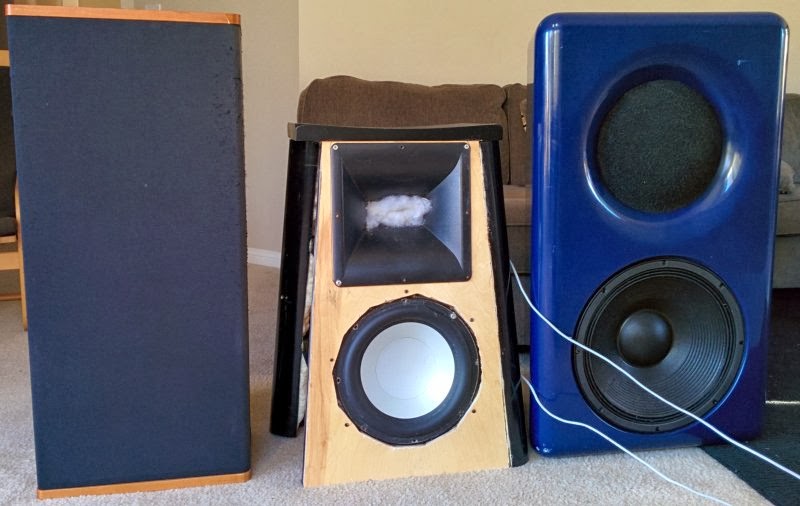
From the front, it doesn't look much smaller. (The other two speakers are Gedlee Summa and Vandersteen 2C
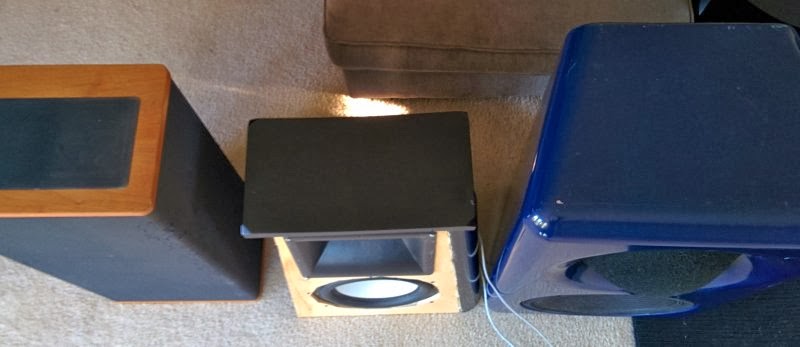

But from the top, you can see the volume of the Monster Massive cabinet is about half.

Every time I watch Breaking Bad my girlfriend asks "are those Summas?" when they show Jesse Pinkman's living room 😱

I wonder if the Summa's girth is due to the fact that it was originally a ported box? Geddes was using JBL as a reference, and the format and size of the Summa is similar. (In the pic above, you can see it as it looked in 2005. I bought mine in 2008.)
According to the B&C spec sheet, the recommended ported box for the 15TBX100 is 4 cubic feet. That's about the same size as the Summa cabinet. Later on, Geddes switched to a sealed alignment.
Maybe the cabinet size was kept the same? Even though it would work in a cabinet about half the size?
For a second I considered that it might be the magnet of the woofer, but it's 7" deep, which is about half the depth of the cabinet.
Long story short, it looks like I could probably reduce the volume of the Summa by about half. Now, obviously, I'm not going to do that. Taking a hack saw to an expensive set of speakers probably isn't a brilliant idea 🙄
Reducing the cabinet volume by half would raise the F3, as you said, probably not a brilliant idea.Long story short, it looks like I could probably reduce the volume of the Summa by about half. Now, obviously, I'm not going to do that. Taking a hack saw to an expensive set of speakers probably isn't a brilliant idea 🙄
Reducing the cabinet volume by half would raise the F3, as you said, probably not a brilliant idea.
My point was the Summa cabinet appears to be the right size for a ported enclosure. And at one point, it *was* ported. But Geddes changed to a sealed alignment, but kept the cabinet volume the same.
Due to this, one could reduce the cabinet volume dramatically and change the response very little.
For instance, the cabinet is currently about four cubic feet. Due to the low QTS of the woofer, this yields a very very low QTC of 0.35 and an F3 of 116hz.
If you halved the enclosure volume, the QTC would rise to 0.42 and the F3 would rise to 123hz.
But that's just six percent; hardly audible I'd say.
It's an interesting thought, because I'm perfectly happy with the sound of the Summas, it's just that the cabinet is so darn big, and the size has become a bigger and bigger problem as I've continued to move. (I bought the Summas when I lived in Oregon, where you can buy a house the size of a Home Depot for about ten dollars. Now I live in San Diego where a home the size of two car garage costs half a million dollars.)
....cut it down by half in depth and be done about it. Wait, would it not be a hump at 120 Hz then?? 800 uF in series? + subwoffer?
....cut it down by half in depth and be done about it. Wait, would it not be a hump at 120 Hz then?? 800 uF in series? + subwoffer?
what's the 800uF?
what's the 800uF?
1st order electrical high pass to get rid of the hump from going to a smaller enclosure.
..yes, hobbyhifi.de has done a few projects using this technique. Judging from published measurement, it extends the bass a bit also until high pass kicks in....
Although I like the direction of dipole bass you have going here. I have four nude 12 inch swinging freely here😱) Best bass I had up to now. Will be interesting what you come up with here, I don't like my full rangers playing nude.
Peter
PS Merry Christmas😱)
Although I like the direction of dipole bass you have going here. I have four nude 12 inch swinging freely here😱) Best bass I had up to now. Will be interesting what you come up with here, I don't like my full rangers playing nude.
Peter
PS Merry Christmas😱)
If you halved the enclosure volume, the QTC would rise to 0.42 and the F3 would rise to 123hz.
0.42 is still exstremely low and should not cause any 'hump issues'
I expect Qtc 0.5-0.6 would give 'optimal rolloff'
(I suppose the angled sides lead to removing the ports)
- Home
- Loudspeakers
- Multi-Way
- Monster Massive